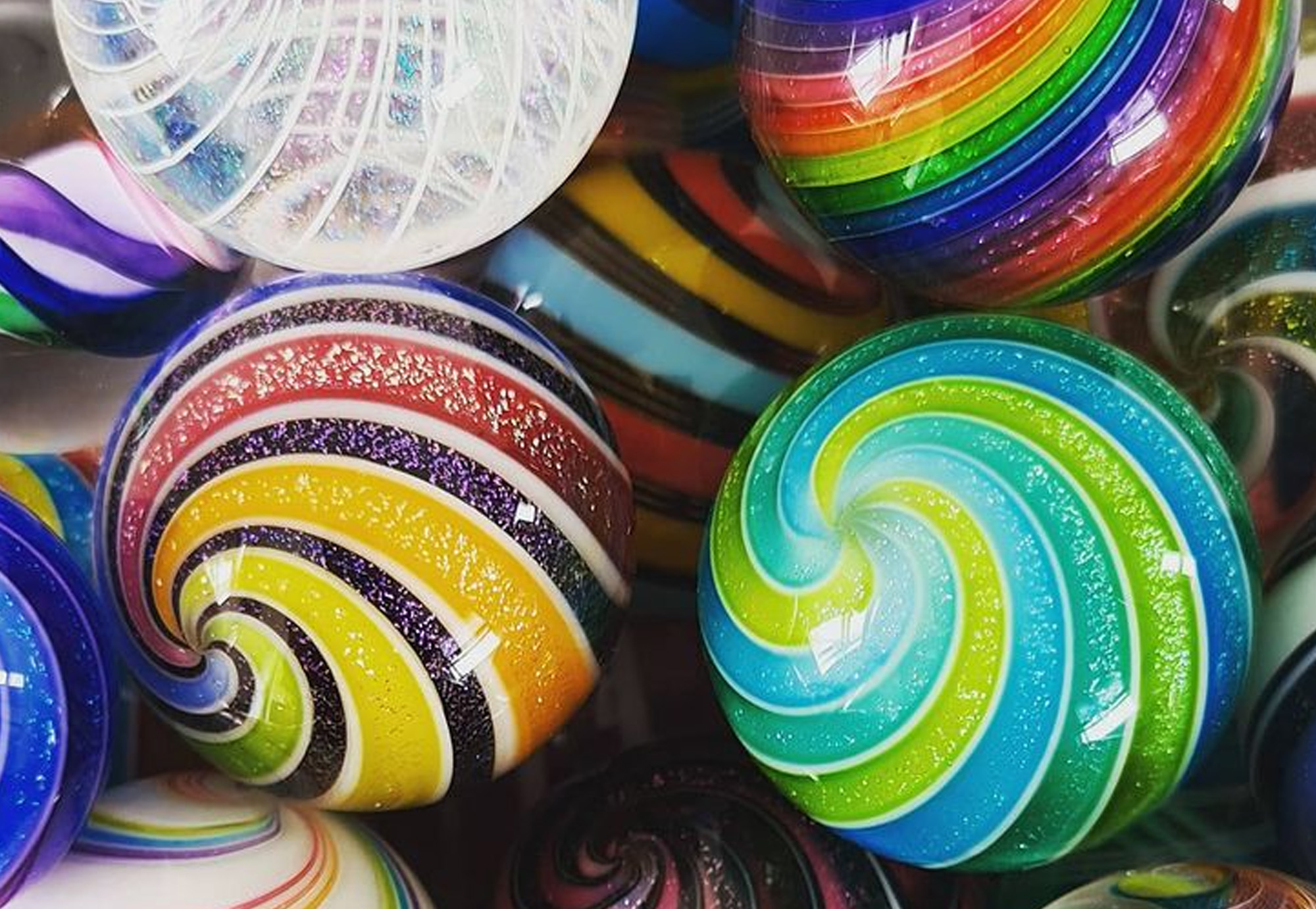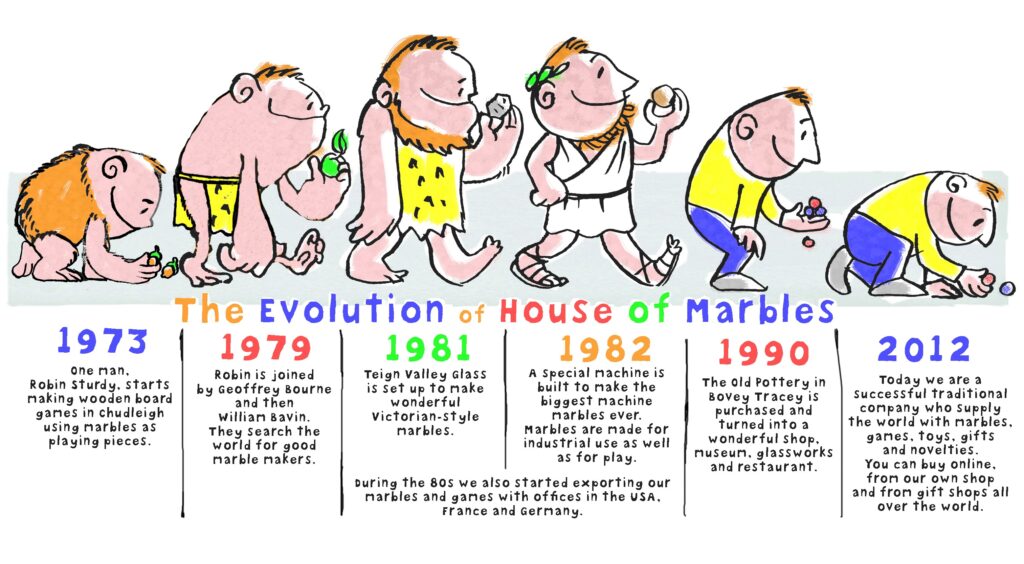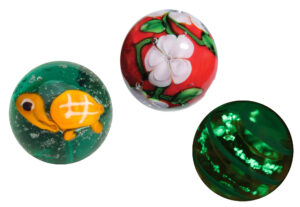
Here at House of Marbles, during our normal day today jobs, wherever we work (be that the restaurant, warehouse, shop, warehouse or office), at some point a member of staff will be asked a question about how marbles are made. In fact, it is one of the things we get asked about most, and for obvious reasons!
What is most fascinating about the process of marble making is the way in which it is so unique compared to almost any other product that might ever be produced. Glass is a wonderful substance to work with and can be manipulated into almost any shape size or finish. It is also a fragile material in many ways, and so when you think about it, making a marble out of something that can break so easily seems like an odd choice for an item that is intended to be rolled on the ground, knocked against other pieces of glass, and generally used and abused.
Glass is also a material that has to be worked at high temperatures, which again seems counter-productive for a product that is sold for literally as little as a few pence. To understand why this material is used is therefore really important.
The evolution of marbles
 Let me take you back in time a moment to ancient Rome, where it is known that marble-like games were played with nuts. Picture those toga-wearing ancestors, happily rolling their walnuts or hazelnuts in a competitive and jovial spirit, as a way to pass the time between the gladiator games and Olympic sports that we know were popular at that time. Why are marbles not an Olympic sport today you ask? It could very well be because of the short shelf life of nuts – how disappointing to discover your favourite ‘shooter’ only for it to have gone off by the time you reach the finals!
Let me take you back in time a moment to ancient Rome, where it is known that marble-like games were played with nuts. Picture those toga-wearing ancestors, happily rolling their walnuts or hazelnuts in a competitive and jovial spirit, as a way to pass the time between the gladiator games and Olympic sports that we know were popular at that time. Why are marbles not an Olympic sport today you ask? It could very well be because of the short shelf life of nuts – how disappointing to discover your favourite ‘shooter’ only for it to have gone off by the time you reach the finals!
After nuts we know that clay was used to produce marbles – it was easy to mould and create in a range of sizes or colours, but sadly not that resistant to constant use. Over time these clay marbles would erode and become misshapen. Not so great for rolling.
Next up was the stone marble, made from marble, quartz or semi-precious materials. Of course, crafting stone into a round shape is not that easy and requires some skill. Years ago, there would have been more people who worked with stone by trade and perhaps they were cheaper to come by. These days you can still get stone marbles, and they are very pretty – generally used in decorative displays for the home, perhaps on the coffee table. You can still use stone marbles for their intended purpose and of course use may lead to some damage but ultimately for a small children’s toy, they are more expensive to make.
Then came the glass marble – created by glassmakers who at the end of the day would gather up any leftover glass and shape it into a ball to take home for their children. These marbles were unsurprisingly referred to as ‘end of day’ marbles and (although made from scraps and offcuts essentially) are highly collectable today. We have some on display here in our Marble Museum in Devon as an example of the origins of marbles.
Glass of course can still break and become damaged with use; however, it can be used to produce a large variety of designs that that are both pleasing to the eye and practical. The thickness of the glass means that while they can still be broken, they can also bear the brunt of the force of a normal game of marbles and live to tell the tale (bye, bye nuts).
Machine made marbles – rolled in a machine!
Glass marbles are no longer made in the way the ‘end of day’ marbles would have been made but can be produced relatively cheaply by pouring molten glass into a marble-making machine that rolls the glass until it is cooled, with the end product being – you guessed it, glass marbles. This does have its limitations though and cannot for example:
- Make individual marbles to an exact size – there is a size that we aim for and what we call a ‘tolerance’ for size variation will normally vary by about 1mm either side of the intended size. Sometimes marbles produced will be over or under the desired threshold and those may be unsuitable for use.
- Make all marbles to exactly the same size as each other – this is the same principle as the above and while marbles within the same batch will normally be more similar in size to one another there will always be some variation.

Another thing that people tend not to realise is that colour is something that can vary widely, and this is the case in all types of glass production (not just marbles). Glass is coloured by the addition of coloured sand, and while there are many shades of this available, how it comes out in production is VERY changeable depending on the atmosphere the day the item is produced. This includes things such as air humidity, temperature and so on. Red glass is a particularly changeable colour that can be bright orange on one day or dark maroon on another (when everything else in the equation remains the same). This is why it is often more expensive to buy red glass AND the reason you may see less pink and purple glass around than other colours because red is an essential element.

Among other things we are asked if marbles can be made with very specific colours, such as brand colours or pantone colours, and unfortunately this is just not possible. Another issue with trying to make marbles for specific purposes is often the expectation of cost and quantity. To be able to obtain and sell machine-made marbles at a very reasonable price (from just 5p depending on size) we need to produce very high quantities of each style! Not many businesses have the capacity to do this, but of course as we ARE House of Marbles and we have hundreds of thousands, or even millions of marbles in stock at any one time, enabling us to sell them to our trade and retail customers worldwide at the great price we do.
Collectors Marbles – made in a glassworks studio.
Should you really NEED to have marbles made to order and the budget is there, then marbles can be produced by hand, and this is something that our glassworks, Teign Valley Glass, are able to do. In these instances, it may not be possible to produce EVERY pattern that people might be able to think of because you are working with molten glass.
In the glassworks studio here in Devon, they make a number of items. They make marbles less often but still with as much attention to detail as any of their other art glass pieces. Marbles produced in the glassworks here would typically be available to purchase for around £40-£60 per marble, so this is by no means a price that most people would associate with marbles.

This is a type of marble that we refer to as a Collector’s Marble or Collectable Marble because they are rarely used to actually play marbles with (except for the odd game of Marble Solitaire perhaps, on a special board). It is more of a display piece to cherish and appreciate, in the same way as other glass items such as paperweights. As with machine made marbles, again it is often very difficult to make marbles to an exact size and the same variation will apply to the colours used in the process. Teign Valley Glass work primarily with clear glass, adding colour to the product as they go, which can be different to the methods other glasswork studios use.
There is a huge market for Collectors Marbles, especially in the USA and some of the designs being produced by today’s top makers are simply stunning by anyone’s standards. Because of the work involved in making these designs marbles can cost up to £1000 or more! The most expensive marble that House of Marbles has ever had for sale was £800! We do have some great Collectors Marbles available from as little as £4.99 though, so do not let it be said that collecting marbles is out of most people’s budgets.
Handmade Marbles – made using the lampworking method of glassmaking
There is also a 3rd option in the array of glassmaking methods that falls between the high end Collectors Marbles and the tiny budget of the machine-made marble range. We refer to these as our handmade marbles. Handmade marbles are made using a process called lampworking. The process is very much as it sounds – a person sitting in front of a small flame (a Bunsen burner type lamp which you may remember from science class in school) working with rods of glass. The rods of various colours are melted and moulded with small parts added to make up various shapes and designs.

Using this method there are more design options available than with machine made marbles (which are essentially just different colour variations of rolled glass mixed together) but fewer options than with Collectors Marbles. This is because typically Collectors Marbles are larger allowing more room to create desired designs. However, we are constantly surprised by the amazing designs that we are able to produce. From floral designs to picture marbles and even, recently, glow-in-the-dark marbles (a fairly modern invention in the glass-making world), we have a wide array of designs, colours, and finishes that many of our customers enjoy collecting and displaying.

Maker’s Marks on marbles
As with Collector’s marbles, Handmade marbles have to be held to be worked on. They are normally attached to a rod of glass that is broken off when the design is complete. This rod ‘stump’ is then smoothed over with heat so that hopefully you will not see where the holding point was at all. However, on closer inspection you may often signs that point to this and many Handmade marbles will retain a maker’s mark.
You will still see maker’s marks on machine made marbles, but these appear in a different form, because they are made using a different method. Typically, the larger the marble the more noticeable those ‘maker’s marks’ will be. We refer to these as ‘roll marks’ on machine made marbles, because where the molten glass is rolled until it cools, the glass on the outside of the marble will cool quicker than the inside. With larger marbles, the outer glass cools as the marbles are still forming and so roll marks are more obvious. Roll marks are more visible on some designs than others and can be seen by some customers as a ‘product issue’, whilst they are just evidence of how a marble has been made.

For this reason, we try to provide actual pictures on our retail website of designs that come in larger sizes, so that you can see the difference in the design from a small to a large marble. Any marble can look significantly different when it is a Peewee size (10–12mm) at the smallest end of the scale compared to when it is our largest Enormous size (50mm).
It is worth noting that makers marks can also appear purposely, as is often seen in collectors marbles where the maker’s mark is either engraved into the marble or added with a drawing in platinum to the base.
Marble finishes
Of course, there are also a wide variety of finishes that can be applied to various different marbles (made by any method), and these are the main ones that people tend to be most interested in:
- Opaque vs clear – glass, colourless or coloured, can either allow light through (clear/transparent) or not (opaque/solid) and variations of this can create many different effects.
- Many Collectors and Handmade Marbles are covered in a clear layer of colourless glass which smooths over any design work and creates the desired finish and shape.
- The larger the marble the less the ‘transparent’ or ‘clear’ glass will allow you to see through it. Although it should still allow light through it will allow less light through than a smaller, less dense marble.
- Frosted finish marbles – any glass can be ‘frosted’ when it has been made. This can be accomplished by either sandblasting the glass to take away the smooth finish, or it can be achieved by using a chemical process. You will be able to picture what a ‘frosted’ finish looks and feels like when you think of sea glass as this is a naturally occurring form of the frosting process.
- Lustred finish marbles – this is a coating that is added to a marble once it has been made which adds an opalescent or iridescent finish. It is not a coloured finish, but transparent, although it tends to glisten with rainbow colours, much like the surface of a puddle of oil.


- Textured finish marbles – some marbles are rolled in small grains of glass (or splattered with paint) that can add a different colour to the outside. This can sometimes mean that the marble is not as round or smooth as people expect and this process tends to be used in machine made marble-making specifically.
Marble sizes
Marbles tend to come in a variety of sizes: What you might call those sizes though will depend on the country and region where you grew up and in many cases the names given to the sizes you used to play with can be very specific to an area and time. Some names are universal of course, but House of Marbles uses these terms:
- Peewee for our smallest 10-12mm marbles
- Small for our 14mm or 16mm marbles
- Medium for 22mm or 25mm marbles
- Giant for 35mm marbles
- Massive for 42mm marbles
- Enormous for 50mm marbles
Collectors’ marbles tend to come with specific mm sizes because each one can be of a unique size.
Because it is important to know all these things when buying a marble from our online shop, we have a page that is dedicated to informing our customers about marble variations, which can be seen here.
There are also SO many more things that you can learn about marbles. This blog is really just the tip of the glass-iceberg so to speak, and this is precisely the reason we have two publications dedicated to informing our customers about marbles. If you want to know more, please take a look at the following books that you can buy online from us:
- The Pocket Book of Marbles
- Marble Booklet – a popular abbreviated version of the above ‘Pocket Book of Marbles’
